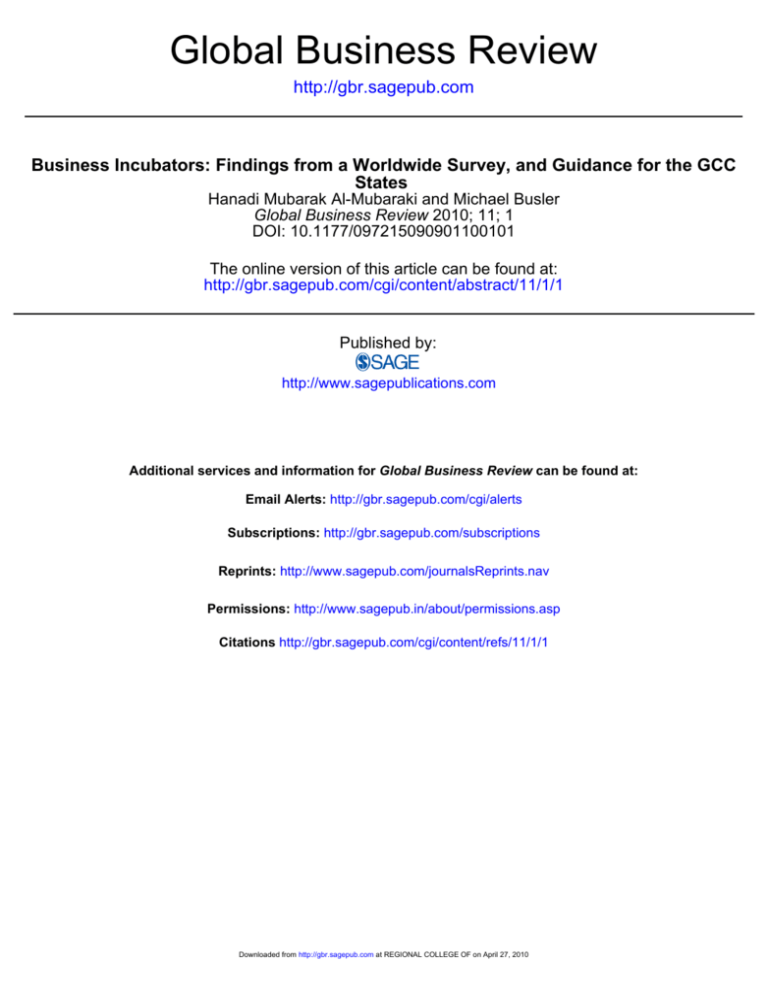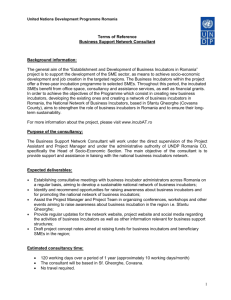Business Incubators
advertisement

Global Business Review http://gbr.sagepub.com Business Incubators: Findings from a Worldwide Survey, and Guidance for the GCC States Hanadi Mubarak Al-Mubaraki and Michael Busler Global Business Review 2010; 11; 1 DOI: 10.1177/097215090901100101 The online version of this article can be found at: http://gbr.sagepub.com/cgi/content/abstract/11/1/1 Published by: http://www.sagepublications.com Additional services and information for Global Business Review can be found at: Email Alerts: http://gbr.sagepub.com/cgi/alerts Subscriptions: http://gbr.sagepub.com/subscriptions Reprints: http://www.sagepub.com/journalsReprints.nav Permissions: http://www.sagepub.in/about/permissions.asp Citations http://gbr.sagepub.com/cgi/content/refs/11/1/1 Downloaded from http://gbr.sagepub.com at REGIONAL COLLEGE OF on April 27, 2010 Business Incubators: Findings from a Worldwide Survey, and Guidance for the GCC States Hanadi Mubarak Al-Mubaraki Michael Busler Business incubators can help young firms to survive and grow during their start-up years, and can play a key role in the economic development of a community or region. In developing countries, like Kuwait and the other Gulf Cooperation Council (GCC) member states, business incubators can be particularly valuable in helping to develop local economies, promote technology transfer, create new enterprises and generate jobs. There is potentially a wealth of information available about the characteristics of and services offered by business incubators in the US and other countries, which can be used to inform the development of incubator programmes within these countries. To tap into this information, an Internet-based survey was conducted with a sample of business incubators worldwide. The survey results are used to make recommendations about how to maximize the success of incubators, including matching services offered to the needs of clients and involving a range of community stakeholders in the development of their programmes. A number of options are proposed for developing and expanding the business incubator concept in Kuwait and the GCC member states. Keywords: Business incubation, entrepreneurship, economic development, Gulf Cooperation Council (GCC) Introduction A business incubation programme can be described as a dynamic process of developing emerging commercial entities. The National Business Incubation Association (NBIA) in the US describes the functions of business incubators as: Business incubators nurture the development of entrepreneurial companies, helping them survive and grow during the startup period, when they are most vulnerable. These programmes provide their client companies with business support services and resources tailored to young firms. The most common goals of incubation Hanadi Mubarak Al-Mubaraki teaches at Kuwait University, Nuzha, Kuwait. E-mail: pro5383526@yahoo.com Michael Busler is Associate Professor at The Richard Stockton College, USA. E-mail: michael.busler@stockton.edu GLOBAL BUSINESS REVIEW, 11:1 (2010): 1–20 SAGE Publications Los Angeles/London/New Delhi/Singapore/Washington DC DOI: 10.1177/097215090901100101 Downloaded from http://gbr.sagepub.com at REGIONAL COLLEGE OF on April 27, 2010 2 Hanadi Mubarak Al-Mubaraki and Michael Busler programmes are creating jobs in a community, enhancing a community’s entrepreneurial climate, retaining businesses in a community, building or accelerating growth in a local industry, and diversifying local economies (National Business Incubation Association 2007). Although the concept of business incubation originated in the US, business incubators can now be found all over the world. They can potentially play a particularly valuable role in developing countries such as Kuwait and the other Gulf Cooperation Council (GCC) member states, where small companies are often struggling to compete in local, national or international markets with relatively few resources and limited technical or business expertise. However, there is little systematic information and guidance available to these developing countries to enable them to establish or promote the development of business incubators. This study aims to help fill the gap by providing research-based data on business incubator programmes from a literature review and a worldwide survey. The information is intended to provide information and guidance to the governments, private entrepreneurs and other actors, particularly in developing countries, who wish to establish business incubators to help meet the business and economic development needs of their countries. intended to create a collegial climate for the training, support, and development of successful small entrepreneurs and profitable businesses. These characteristics may include the initial selection of early-stage or startup entrepreneurial firms with potential for growth; designated work spaces provided for each tenant; shared facilities necessary to operate the business; shared support such as communications and administrative assistance; a small management team which can train, develop and assist the new entrepreneurs; access to critical professional services such as legal and financial assistance and affordable rent and fees for services. Incubation programmes work to achieve various goals, such as commercializing new technologies from universities, diversifying local economics, serving minority entrepreneurs and creating jobs. Increasingly, incubators are being established to help companies grow for particular markets, which might be as diverse as gourmet foods, biotechnology or the arts. They can play a central role in the development and growth of a local, regional or even national economy by facilitating business development and expansion, helping to develop markets and creating jobs. Research in business incubators in the US indicated that around 70 to 90 per cent of incubator graduates, on average, remain successfully in operation following graduation from the incubator programme (Molnar et al. 1997). Functions of Business Incubators Types of Business Incubators A business incubator programme consists of a controlled work environment distinguished by particular characteristics that are all The National Business Incubation Association classifies incubator programmes in various ways, with the primary distinction between Global Business Review, 11:1 (2010): 1–20 Downloaded from http://gbr.sagepub.com at REGIONAL COLLEGE OF on April 27, 2010 Business Incubators: Findings from a Worldwide Survey 3 non-profit and for-profit organizations. In the US, non-profit incubators were estimated to account for about 85 per cent of the total US incubator population of around 950 in 2002 (Linder 2002). These are further split into three categories: (i) stand-alone incubators; (ii) incubators that are programmes or departments of larger tax-except entities and operate within their tax status such as university or government-run incubators and (iii) incubators that work closely with other organizations whether for-profit or not-for-profit, to achieve their missions. Whereas non-profit incubation programmes generally have missions that focus on economic development outcomes, most for-profit programmes are set up to obtain a sizeable return on investments for their shareholders. The NBIA recognizes three major types of for-profit incubators, which are further categorized according to how investors anticipate obtaining a return on investment (Temali and Campbell 1984). The first type anticipates return on investment from rents and service fees. This type of incubator generally adds a few company development services to what is basically a package focused on office services and flexible real estate, completes the job and leaves. The second type of for-profit programme treats the incubator as a portfolio of investments and seeks returns on equity holding in start-up companies. Corporate incubators, the third type, seek benefits primarily from spinning out technologies or spinning in mental or medical innovations with strategies. Additionally, new hybrid models have married some of these elements. NBIA also classifies business incubators by other characteristics including geography (urban, suburban and rural), sponsoring entity (for example, university or college, government, economic development organization and corporation) and industry sector (technology, mixed-use manufacturing, services and ‘other’) (Molnar et al. 1997). The range and types of services offered by an incubation programme depend on the types of clients served. Thus, the services offered to emerging technology companies fostered in a university incubator, for example, will usually differ from those offered to entrepreneurs developing non-technology companies in distressed inner-city neighbourhoods. The former group of companies might have highly educated and technically-skilled staff but require expertise on marketing and promoting a fast-growth company. In the latter case, on the other hand, clients may possibly lack both basic business literacy skills and technical expertise and need support in both these areas. Economic Development Goals Business incubators can play an active role in local, regional and national economic development efforts. A business incubator, however, cannot transform an economy and must be integrated into the broader economic policy reform, infrastructure investment and financing. Business incubators can be used for one or more of the following economic development purposes: New business formation: New business formation is the most common economic development focus of business incubators around the world. These programmes focus on supporting Global Business Review, 11:1 (2010): 1–20 Downloaded from http://gbr.sagepub.com at REGIONAL COLLEGE OF on April 27, 2010 4 Hanadi Mubarak Al-Mubaraki and Michael Busler entrepreneurs from business concept development to product launch. Their purpose is to nurture businesses until they are stable enough to operate without the day-to-day support of the incubator. Business stabilization: A number of countries around the world have started investigating ways in which business incubators can be used to help existing small-to-medium sized enterprises that have become unstable, perhaps as a result of labour problems, new government regulations or policies, new competitors, market changes or pressures associated with rapid growth. The purpose of these programmes is to provide business support services and guidance to help stabilize the business and reduce the chances of failure. Business expansion: A number of countries have also started using business incubators to help the existing small-tomedium sized enterprises to expand. These programmes provide services to help business owners improve operational efficiency, to identify and access new markets, expand production capabilities, hire and manage labour and secure capital. The purpose of these programmes is typically to help businesses with one to five employees expand into businesses with 10 to 20 employees. Growth and Numbers of Incubators Although the first formal business incubator is believed to have been established in the US in 1959, followed by a limited number of others opening over the next few decades, the concept really took off in the US in the mid1980s. At this time, the Small Business Administration (SBA) released a study that concluded that a majority of the new jobs were being created by the small businesses, creating a boom in incubator development and resulting in the creation of the National Business Incubator Association (NBIA) in 1995. In the 20-year period since the concept of business incubation programmes began to take root in the US, the industry has grown rapidly and matured considerably, and it has been estimated that at present, there are more than 1,400 business incubators operating in North America and an estimated 5,000 worldwide (NBIA 2007). It is expected that the number of business incubators throughout the world will continue to increase over the next few decades as more and more communities, countries and private investors recognize the value of this effective tool for supporting new business formation and for facilitating economic growth. Business Incubators in Developing Countries—China and India China and India represent examples of two developing countries where business incubators are playing an important role in economic development. In the case of China, it has been observed that the business incubator programmes have played a key role in facilitating the country’s transition from a socialist to a market economy, by enabling the commercialization of technological developments and by promoting a culture of innovation across the country (Lalkala 2003). Before the Global Business Review, 11:1 (2010): 1–20 Downloaded from http://gbr.sagepub.com at REGIONAL COLLEGE OF on April 27, 2010 Business Incubators: Findings from a Worldwide Survey 5 economic reforms which began in the late 1970s, science and technology research was not commercially driven and there was little incentive to adopt new technologies. From the late 1980s onwards, however, there was a need to provide an environment which was more conducive to R&D, and business incubators were seen as the solution. Sponsored by the Chinese government, with support from the United Nations (UN), business incubators were first implemented in the early 1990s, under the Ministry of Science and Technology’s Torch Program. The programme developed rapidly and by 1999, China reportedly had the third largest business incubator programme in the world, with 127 incubators located throughout the urban and rural areas of the country by 1999, and an additional 64 ‘software parks’ which had similar functions. Over time, government sponsorship and administration of business incubators has been delegated to lower levels such as County and District Science and Technology Commissions, and a number of university-sponsored and public-private partnership incubators have also appeared. University incubators and university science and technology parks have been among the fastest growing areas of business incubator development in recent years. Overall, a majority of the business incubator tenants in China have been offshoots of universities, research institutes and government enterprises that continue to be financed and owned by their parent institutions. Although most business incubators in China are not-for-profit, there are a number of for-profit privately sponsored incubators (Lalkala 2003). A very high proportion of China’s business incubators have been technology-focused, with the primary aim of bringing technology development to the market. A wide range of specialist technology areas have been covered including information technology, biotechnology, pharmaceuticals and aerospace. Additionally, a number of more specialized incubators have been created with other types of objectives including the International Business Incubators, which assist both foreign and Chinese companies to enter the Chinese as well as the international markets. In many areas of China, incubator networks have come up which link incubators in a single region and allow for sharing of resources and support. Another reported development has been the establishment of a small number of non-technology incubators with social as well as economic objectives, such as facilitating business start-ups by laid-off workers, including women (Lalkala 2003). An analysis of data available on 77 incubators sponsored under the Torch Program (Lalkala 2003) indicates that they are likely to provide a good return on investment, with the investment for the year of 1998 likely to be covered by tax receipts alone in the following five years. Also, additional benefits are provided in the form of job creation, taxes payable by suppliers and customers of the incubator tenants and other values associated with promoting innovation and marketing technology. Although China’s business incubator programme is generally seen as being very successful, its reported weaknesses include its over-emphasis on technology enterprises, inadequate business expertise on the part of public sector managers and insufficient ‘ownership’ of the incubators within the communities in which they are located (Lalkala 2003). Global Business Review, 11:1 (2010): 1–20 Downloaded from http://gbr.sagepub.com at REGIONAL COLLEGE OF on April 27, 2010 6 Hanadi Mubarak Al-Mubaraki and Michael Busler Business incubators have also played a major role in India’s recent economic development, according to a UN report (n.d.). In India, like China, business incubators have formed an important part of the government’s science and technology policy. In contrast to China, there has been a longer-term emphasis in India on the use of science and technology in promoting national economic development. However, although India is further forward in terms of its technology culture, shortcomings in the business infrastructure and support systems have reportedly formed barriers to the more rapid commercialization of R&D in India. In response, the Ministry of Science and Technology has implemented a number of programmes to improve the business environment for small businesses and start-up firms, including a Technology Business Incubator scheme. This was introduced with assistance from UNDP’s Technology Management Programme Support (TMPS) sub-component Nurturing Technological Entrepreneurship through STEPs and TBIs, under which two TBIs are being established. It is expected that the use of TBIs in India will improve the likelihood of business success for tenant organizations, as well as in forming an economic development tool and means of generating jobs, income and taxes. This brief overview of business incubator development in China and India demonstrates the ways in which business incubators can make an important contribution to the economic development by improving the business and cultural environment for the commercialization of science and technology. It also highlights the availability of external sources of support to developing countries, notably from the UN, to facilitate the development and implementation of business incubator programmes. The available evidence on China’s business incubator programme, in particular, demonstrates the potential that business incubators offer developing countries in terms of economic development, cultural transformation, job creation and income generation. Business Incubators in the GCC States In the GCC member states, efforts to support entrepreneurship through business incubators and similar facilities are on the increase. In Manama, in the Kingdom of Bahrain, The Bahrain Development Bank and the United Nation Industrial Development Organization have established the Business Incubator Center to support new business formation in the country, in cooperation with the Commercial and Industry Ministry’s Industrial Affairs. The programme has been built around an entrepreneurial trading programme that includes classroom inputs with counselling and support services. The services offered include business opportunity identification and selection, organization of market information, business plan preparation, raising financial resources, obtaining approval clearances from the government and technology sourcing from other countries. The Emirate of Dubai in the United Arab Emirates (UAE) has recently established the Dubai Internet City to foster the development of technology ventures involving the Internet, information technology and other related technology sectors. In the Kingdom of Saudi Arabia, the King Fahd University of Petroleum and Minerals is investigating the development of a business incubator in Dammam, and several organizations are investigating Global Business Review, 11:1 (2010): 1–20 Downloaded from http://gbr.sagepub.com at REGIONAL COLLEGE OF on April 27, 2010 Business Incubators: Findings from a Worldwide Survey 7 opportunities for developing a business incubator in Riyadh. Aims and Methods In developing countries, including Kuwait and the other GCC member states, business incubators might be particularly valuable in helping to develop local economies, promote technology transfer, create new enterprises and generate jobs. There is potentially a wealth of information available about the characteristics and services offered by business incubators in the US and other countries, which might be used to inform the development of incubator programmes within these countries. In order to tap into this information and to find out about the actual experiences of business incubators, an Internet-based survey and a number of electronic interviews were conducted with the members of NBIA with the survey representing a wide range of countries worldwide. Data were collected by means of an electronic survey questionnaire and an interview schedule administered to NBIA members via the World Wide Web. The survey questionnaire and electronic interview schedule were designed and uploaded to an online survey website. The survey questionnaire was intended to provide quantifiable information on the characteristics of business incubators around the world, including geographical location, area of residential accommodation for businesses, sponsoring entities, goals of the programme, services offered, services required by clients, barriers and obstacles encountered and financial data. The electronic interviews were intended to collect more in-depth information about the operation and impact of incubators by drawing on the views and experiences of their managers. After receiving permission from the NBIA to contact its members and ask them to participate in the survey, the researcher compiled a list of 711 NBIA members who were business incubators, and sent them e-mail invitations to take part in the survey. The e-mails contained a link to a questionnaire on Survey Monkey, an online survey website. Participants were told about the purpose of the project and were given specific instructions for completing the questionnaire. The survey was made available at the SurveyMonkey portal beginning on 1 April 2006 for 30 days, at the end of which, the survey was closed and the hosting company collected the data and returned it to the researcher. The data did not include any identifiable information on those who had taken part in the survey. Ninety-two interview invitations were sent out to incubator managers at the same time when the survey invitations were being sent. Of the 711 survey invitations that were e-mailed to the NBIA members, 43 were returned as undeliverable, leaving a sample frame of 668. The total number of survey responses was 105, representing a response rate of about 16 per cent. However, only 45 were completed in full, so data are available for less than 105 respondents on many of the variables. Additionally, six business incubator managers responded to the interview invitations and subsequently completed the interviews. Relevant comments from these interviewees have been incorporated into the following sections on the survey results. Overall, the relatively low survey response rate means that the results cannot be regarded Global Business Review, 11:1 (2010): 1–20 Downloaded from http://gbr.sagepub.com at REGIONAL COLLEGE OF on April 27, 2010 8 Hanadi Mubarak Al-Mubaraki and Michael Busler as representative of all the NBIA business incubator members. However, respondents did represent a wide range of countries and organizations and, as such, can be regarded as a diverse sample providing a good overview of the types and characteristics of business incubators and the range of services that they provide. Results Location of Incubators Table 1 shows the countries in which the respondents’ incubators were located. A total of 78 respondents answered this question, of which 66 per cent (N = 52) were from the US Table 1 Location of Incubators Country Number of Respondents Australia Belgium Canada Cyprus Finland Hong Kong Jamaica Mexico Mongolia N. Ireland New Zealand Oman Pakistan Palestine S. Africa Singapore Taiwan Tunisia USA Total 4 1 3 1 2 1 1 1 1 1 1 1 1 1 3 1 1 1 52 78 Source: Authors’ own. and the rest were broadly distributed over the globe. Twelve (23 per cent) incubators were located in developing countries. Client Catchment Areas Of the 45 respondents, who reported where they drew the majority of their clients from, the largest percentage (40 per cent, N = 18) said that they came from urban areas, whereas 31 per cent (N = 14) said that they drew their clients from suburban areas. Around 22 per cent (N = 14) said that most of their clients came from rural areas, 15.6 per cent (N = 7) said that they served a national catchment area, but very few (4.4 per cent, N = 2) indicated that they were multinational in scope. One interview respondent commented that their organization could not afford to be too narrowly focused in terms of the catchment area, since they were based in a sparselypopulated area. Another respondent also highlighted the importance of having a wide base of prospective tenants, indicating that incubators may need to draw their clients from a fairly wide geographical area in order to be able to survive economically. Age of Incubators A total of 79 respondents provided information on the time period when their incubator was founded. Nearly three-quarters (73 per cent) had been founded in the period since 1996, with more than half (53 per cent) founded between 2001 and 2006. However, nearly 14 per cent (N = 11) of the respondents said that their incubators had been founded before 1990. Moreover, two of the interview respondents reported that their business incubators had been established more than Global Business Review, 11:1 (2010): 1–20 Downloaded from http://gbr.sagepub.com at REGIONAL COLLEGE OF on April 27, 2010 Business Incubators: Findings from a Worldwide Survey 9 20 years ago. One interviewee observed, when asked about the history of the incubator, that it had been through several distinct stages, from an initial very active phase, followed by a period of disinterest and decline and a recent revitalization. These states seemed to be largely dependent, according to the respondent, on the particular leadership of the incubator at different times. Overall, these results indicate that many business incubators are very well-established, and it can be inferred from this that they are likely to be contributing value to the economies and communities in which they are based, although the extent of their success in doing so is likely to be dependent on a range of factors including leadership styles. Sponsoring Entities and Stakeholders Table 2 shows data about the sponsoring entities of the sample. Seventy-five out of the 79 respondents indicated that they had a primary sponsoring entity, with academic institutions accounting for a third of all sponsors, followed by government agencies (25.33 per cent, N = 19). Economic development organizations also accounted for a significant number (21.33 per cent, N = 16) of sponsoring entities (Table 2). The interview respondents were asked a number of questions about their stakeholders and customers. When asked about who they considered as the incubator’s ‘customers’, most respondents indicated that these were defined fairly broadly to include their tenant companies, members of their Boards of Directors and stakeholders, such as the city council’s economic development officials. All the interview respondents reported that their Table 2 Primary Sponsoring Entities Number of Respondents Type Academic Government Econ. Dev. Org For-profit Hybrid Tech. CG Other Total 25 19 16 4 2 0 9 75 Per cent of Total 33.3 23.3 21.3 5.3 2.7 0.0 12.0 100.0 Source: Authors’ own. tenant companies were considered as customers or stakeholders of the incubator. Business incubator managers were also asked to explain how oversight and advice is provided to the programme and whether there is a Board of Directors or Advisors. It became clear that most did have Boards of Directors and that these played a leading role in managing the incubators. Often, the board was seen as the main mechanism by which the incubator’s stakeholders represented their interests and influenced the incubator’s programme of work. Several explained that the board was responsible for functions such as approving the budget, setting policy and reviewing applications for tenancy. All of the interviewees indicated that regular reports are submitted to stakeholders, either on a monthly, weekly or a bi-weekly basis, although one noted that there are no formal mechanisms for communicating with stakeholders other than the Board. However, two interview respondents did remark that they also had close links with the local community organizations, including economic development and small business development organizations, and said that they were proactive in promoting Global Business Review, 11:1 (2010): 1–20 Downloaded from http://gbr.sagepub.com at REGIONAL COLLEGE OF on April 27, 2010 10 Hanadi Mubarak Al-Mubaraki and Michael Busler awareness about the incubators’ role and developing community linkages. Primary Functions and Priority Goals Figure 1 shows the distribution of respondents by their incubators’ primary programme function. Just under half (43.96 per cent, N = 40) indicated that the primary purpose of their incubator was to foster technology companies, followed by more than a third (36.26 per cent, N = 33), who indicated that their programme could best be described as supporting a mixture of businesses (mixed use). The rest described their programmes as service-business oriented (4.4 per cent, N = 4), web-related (3.3 per cent, N = 3), manufacturing and community revitalization (2.2 per cent, N = 2) or other (7.69 per cent, N = 7). Figure 1 Description of Programme a Source: Authors’ own. Note: aN = 91. Table 3 shows the distribution of responses regarding the priority goals of incubators for the 45 survey respondents who answered this question. Respondents were asked to rate the importance, on a five-point scale, of a number of listed goals from ‘very high’ to ‘very low’. Of the items listed, ‘creating jobs in the local community’ was rated ‘very high’ by the largest percentage of respondents (58 per cent, N = 26), closely followed by ‘enhancing the community’s entrepreneurial climate’, ranked as a ‘very high’ priority by 56 per cent (N = 25). Other goals which were ranked as ‘very high’ by more than a quarter of all respondents were ‘commercializing technologies’ (42 per cent), ‘building or accelerating growth in local industry’ (38 per cent), ‘diversifying the local economy’ (31 per cent) and ‘supporting other entrepreneurs and the community’ (27 per cent). The survey results show that ‘revitalizing distressed neighbourhoods’ and ‘moving people from welfare to work’ were not regarded as important goals by incubators, with more than half of the respondents giving each of these a ‘low’ or ‘very low’ priority in total, and a further third indicating that they were neither high nor low priority. The interviewees were asked what they understood as the purpose of business incubators and about any gaps between the goals and the reality in this picture. Job creation was the most popular response, while some also cited affordable business assistance for new or emerging businesses, and one stressed the goal of economic development. Only one respondent commented on the gap between the goals and the reality, remarking that their incubator is currently focused on the provision of space rather than services. Another noted that the goals of their incubator are currently ill-defined. Although it is not known how representative the latter respondent is of incubator managers generally, it is Global Business Review, 11:1 (2010): 1–20 Downloaded from http://gbr.sagepub.com at REGIONAL COLLEGE OF on April 27, 2010 Business Incubators: Findings from a Worldwide Survey 11 likely that incubators that do not have welldefined goals are not performing as effectively as they might, if their efforts were more focused. The fact that a majority of the survey respondents were able to answer the question about their incubators’ goals, however, suggests that most incubators do have fairly welldefined objectives, whether or not these are formalized in writing. Provision of and Demand for Services Table 4 shows the numbers and percentages of respondents whose business incubators offer particular types of services. Forty-four respondents answered this question. The results indicate that most of the incubators offer a wide variety of services, with the majority offering business help, networking, shared administrative/office services, linkages to strategic partners and the like. Very few offered funding (N = 8) or loan guarantee programmes (N = 2). Table 5 reports the numbers and percentages of respondents who believed that their incubator clients were in need of various listed services. A total of 41 replied to this question. All respondents indicated that their clients needed marketing assistance (100 per cent), while a vast majority reported that they need help with business (98 per cent), linkages to strategic partners (95 per cent) and networking activities (90 per cent). Overall, the results indicate that incubator clients are seeking help with a very wide range of business activities. With the exception of childcare services, which were apparently not sought by any clients, at least a quarter of all respondents in each case said that their clients were in need of each of the listed services. The interviews provided little evidence that feasibility studies had been conducted to identify the needs of entrepreneurs and their start-up firms, although it was generally assumed by respondents that these included services such as financing, financial Table 3 Priority Goals of Incubatorsa Very High Per cent Goal Creating jobs in local community Enhancing community’s entrepreneurial climate Retaining business in local community Building/accelerating growth in local industry Diversifying local economy Identifying potential spin-in/spin-out opportunities Commercializing technologies Supporting other entrepreneurs and the community Generating benefits for the sponsoring organizations Revitalizing distressed neighbourhood Moving people from welfare to work 58 56 22 38 31 20 42 27 16 2 2 High Neither High Low Per cent nor Low Per cent Per cent 38 36 36 51 33 42 29 56 22 9 9 2 9 29 9 31 29 16 16 42 33 31 0 0 13 2 2 4 9 2 11 22 9 Very Low Per cent 2 0 0 0 2 4 4 0 9 33 49 Source: Authors’ own. Note: a N = 75. Global Business Review, 11:1 (2010): 1–20 Downloaded from http://gbr.sagepub.com at REGIONAL COLLEGE OF on April 27, 2010 12 Hanadi Mubarak Al-Mubaraki and Michael Busler Table 4 Services Offered a Service Number of Respondents Help with business networking activities Shared administrative/office services Linkages to strategic partners Marketing assistance Internet access Linkage to higher education resources Help with accounting/financial management Linkages to angel or venture capital investors Business assessment Intellectual property management Help with presentation skills Shadow advisory boards/mentors Help accessing commercial bank loans Personal development/training Specialized equipment/facilities Commercializing technology Human resources General legal services Management team identification Help accessing specialized non-commercial loans Help with business etiquette Comprehensive business training programme Assistance with product design and development Assistance with manufacturing practices Federal procurement assistance International trade Assistance with e-commerce Services/inventory/management Economic literacy training In-house investment funds Loaned executive to act in management capacity Loan guarantee programmes Child care/services Other (please specify) 44 43 42 39 38 36 35 34 34 32 31 31 30 30 28 28 24 24 22 21 21 20 18 17 15 14 13 12 8 8 6 2 2 2 Per cent 100 98 95 89 86 82 80 77 77 73 70 70 68 68 64 64 55 55 50 48 48 45 41 39 34 32 30 27 18 18 14 5 5 5 Source: Authors’ own. Note: a N = 44. management, technical support and accommodation. When asked about the type of entrepreneurial training currently offered, the interview respondents mentioned basic business skills, business planning, financial management and small projects. Cost was the factor mentioned by almost all the interview respondents as the reason for offering or not offering particular types of services, while one or two mentioned that the services were just not available in their area, for example in a rural area. When unable to offer the services Global Business Review, 11:1 (2010): 1–20 Downloaded from http://gbr.sagepub.com at REGIONAL COLLEGE OF on April 27, 2010 Business Incubators: Findings from a Worldwide Survey 13 Table 5 Services Neededa Service Number of Respondents Marketing assistance Help with business Linkages to strategic partners Networking activities Internet access Help with accounting/financial management Linkages to angel or venture capital investors Help with presentation skills General legal services Shared administrative/office services Business assessment Personal development/training Intellectual property management Shadow advisory boards/mentors Help accessing commercial bank loans Comprehensive business training programmes Management team identification Commercializing technology Human resources Specialized equipment/facilities Help with business etiquette Help accessing specialized non-commercial loans Assistance with product design and development Assistance with e-commerce Services/inventory/management International trade Federal procurement assistance In-house investment funds Assistance with manufacturing practices Loaned executive to act in management capacity Economic literacy training Loan guarantee programmes Child care/services 41 40 39 37 35 35 35 34 34 33 33 32 32 31 30 28 28 27 26 25 23 22 21 20 19 19 18 15 14 14 13 11 0 Per cent 100 98 95 90 85 85 85 83 83 80 80 78 78 76 73 68 68 66 63 61 56 54 51 49 46 46 44 37 34 34 32 27 0 Source: Authors’ own. Note: a N = 41. themselves, one incubator manager reported that they referred tenants to other agencies such as the Small Business Development Centre, the local community college or the university. Several of the incubator managers interviewed stressed that they saw it as their own responsibility to adapt to the existing programmes or services to meet new needs and shifting priorities as their own, with input from other key stakeholders and approval from their Boards of Directors and by keeping in close contact with tenant firms. However, others offered no evidence of any specific Global Business Review, 11:1 (2010): 1–20 Downloaded from http://gbr.sagepub.com at REGIONAL COLLEGE OF on April 27, 2010 14 Hanadi Mubarak Al-Mubaraki and Michael Busler processes or procedures for updating their range of services to meet changing needs. Client Performance Figure 2 shows the most likely reasons for clients graduating from respondents’ incubator programmes. A total of 45 respondents answered this question, and could give more than one response. The most common reasons for graduation were—outgrowing the space, spending the maximum time allowable and having reached mutually agreed on milestones (N = 30), followed by the growth rate exceeding the limits of the programme and achieving a liquidity event (N = 16). Acquiring an experienced management team (N = 9) and attracting another source of funding (N = 6) were the least common reasons for graduating. Table 6 shows how often incubator clients encounter various types of obstacles in their performance, according to the survey respondents. Respondents were asked to rate how frequently these were encountered by their clients. Lack of financing was rated as an obstacle experienced either ‘almost always’ (44 per cent, N = 19) or ‘frequently’ (35 per cent, N = 15) by the respondents. This was followed by the lack of expertise in entrepreneurship and lack of personal economic resources. Lack of personal financial resources was a problem 65 per cent of the time; inadequate management was also reported to be a frequent problem by 56 per cent (N = 24). The interview respondents were asked how they know when and how a firm is benefiting from its being in the incubator. Interestingly, a number of respondents could not Figure 2 Reasons for Graduating from Programmea Source: Authors’ own. Note: a N = 91. Global Business Review, 11:1 (2010): 1–20 Downloaded from http://gbr.sagepub.com at REGIONAL COLLEGE OF on April 27, 2010 Business Incubators: Findings from a Worldwide Survey 15 Table 6 Perceived Frequency with Which Incubator Clients Encounter Specified Obstaclesa Almost Always Per cent Obstacle Lack of financing for company Lack of expertise in entrepreneurship Lack of customer acceptance Incomplete/inadequate management team Limited market potential Lack of personal economic resources Lack of business literacy or education Unwilling to accept advice Distance or access to networks Lack of technology literacy 44 19 9 16 5 21 5 0 2 2 Frequently Sometimes Not Very Never Per cent Per cent Often Per cent Per cent 35 47 12 40 26 44 33 19 21 16 19 28 67 37 49 23 33 44 37 30 2 7 9 7 21 9 26 35 37 37 0 0 2 0 0 2 5 2 2 14 Source: Authors’ own. Note: aN = 43. answer this question. Others cited factors such as business growth, profits and outgrowing their incubator space. When asked about the types of firms which were being helped by the services provided by the incubator, most respondents cited the technology firms; some also mentioned manufacturing firms. Incubator Performance and Management Styles When asked about the incubator ’s financial situation, all the incubator managers interviewed, noted that their incubator was currently profitable. In one case, the management by the incubator of two additional government-owned buildings was reported to be a model, which was proving to be successful and this respondent noted that financial self-sufficiency gave the incubator more flexibility. When asked about how the managers measured their own performance and that of the incubator, the most commonly cited response, given by nearly all the respondents, was—not profit but successful graduation of tenant firms. However, profit along with the proportion of space occupied and graduation rates, were the types of factors used in setting performance goals and objectives, monitoring performance and reporting to the Board of Directors. Some interview respondents expressed a recognition that as they grow, they would need to define their goals and objectives more clearly and be more sophisticated in their monitoring of these. A majority of the interviewees reported that their own professional background and training was in management or economic development, and stressed that it was their high level of training in these areas which qualified them to provide the type of business counselling and other support services required by their tenants. When asked about their specific style of management, those who gave a response were most likely to stress strong communications or a hand-on management style. This was also reflected in their responses to a question about the kind of Global Business Review, 11:1 (2010): 1–20 Downloaded from http://gbr.sagepub.com at REGIONAL COLLEGE OF on April 27, 2010 16 Hanadi Mubarak Al-Mubaraki and Michael Busler relationship that they try to establish with entrepreneurs and their companies, which was described by most interviewees using terms such as ‘supportive’, ‘cooperative’ and ‘involved’. Hardly any claimed to have experienced any forms of tension in their various roles as incubator managers, although one respondent did emphasize that they sometimes had to be direct and assertive to ensure that the incubator rules were followed by the tenants. Developing Countries Table 7 provides an overview of the characteristics of the 12 incubators in the survey sample that are based in developing countries. Of these, three were located in South Africa, while the rest were sole respondents from nine other developing countries. Developing country incubators were diverse in terms of their client catchment areas, with two being multinational in scope (Singapore and Cyprus), while others either served a national client base or drew clients from an urban area. Most developing country incubators were technology-focused. More than half (N = 7) of the developing country incubators for which information was provided (N = 11), were sponsored by academic institutions, with the remainder divided among economic development organizations (N = 2) and forprofit entities (N = 2). Table 7 Characteristics of Developing Country Incubatorsa Country Geog. Area Jamaica Urban Mexico Mongolia Urban/ National Urban Pakistan Gross Sq. F. When Founded Type of Sponsor Description of Programme Tech./Service/Web 23,000 1991–1995 538,195 1991–1995 1,100 1991–1995 Urban 12,000 1991–1995 South Africa Urban 21,527 1991–1995 South Africa Urban 6,135 1991–1995 Tunisia Urban 4,305 1996–1999 Cyprus Palestine Singapore Multinational National National/ Multinational National National 4,305 1,000 20,000 2001–2006 Before 1981 Before 1981 Academic Institution Academic Institution Academic Institution Academic Institution Academic Institution Acad./Econ. Dev. Org. Academic Institution For-Profit Entity Econ. Dev. Org. For-Profit Entity 5,382 43,056 1991–1995 – – – South Africa Oman Source: Authors’ own. Note: a N = 12. Global Business Review, 11:1 (2010): 1–20 Downloaded from http://gbr.sagepub.com at REGIONAL COLLEGE OF on April 27, 2010 Tech./Service Technology Technology Mfg Technology Mixed-use Technology Technology Mixed-use Tech./Mfg. Tech./Web Business Incubators: Findings from a Worldwide Survey 17 A majority (N = 9) of the developing country incubators had been founded before 1995; only one had been founded within the last five years, so most were already well-established. The gross square footage of the developing country incubators ranged from a high of 538,195 sq. ft (Mexico) to a low of 1,000 sq. ft (Palestine), with a median area of 9,068 sq. ft, and this was identical to the range of all incubators in the sample. Discussion and Recommendations Small business incubators are business assistance centres that provide start-up companies with a supportive and affordable environment and a range of administrative, consulting and networking services. Fundamentally, these programmes, which may be managed by economic development agencies, local governments, for-profit businesses or colleges and universities, function as ‘nests’ in which to hatch and from which to fledge new companies. Incubators offer advantages such as low cost space, shared equipment and services, and the friendship and support of other entrepreneurs. Incubators usually provide space to a selected group of tenants, who remain for two to three years and then graduate to commercial space. The results of the survey and interviews show that small business incubators vary widely in size, sponsorship and budgets. Most incubators serve a locally or nationally based clientele and are primarily directed at fostering small technology businesses for the primary purpose of encouraging employment growth and economic development in the areas that they serve. Also, most incubators offer a variety of services to entrepreneurs. A comparison of the survey results regarding the services commonly provided by incubators, with the perceived needs of clients, reveals that while incubators are meeting the needs of entrepreneurs in several important ways, a number of them are also failing to meet the needs of these small companies in other respects. This is also reflected in the findings regarding the commonly encountered obstacles of incubator clients, which were perceived by respondents to include lack of financing, lack of expertise in entrepreneurship, lack of personal economic resources and inadequate management. Given entrepreneurs’ pressing needs for capital (both business and personal) and management know-how, it would appear that the provision of space and office services, while helpful, should not be the primary concern of incubator clients. To succeed, small business incubators need to help their clients succeed. This can be accomplished by bringing the services that they provide in alignment with the needs of the entrepreneurs who are their clients. However, as was noted earlier, most survey respondents identified the primary purpose of incubators as providing a base for economic development and job creation. This suggests that incubators also need to take into account the needs of the community as well as those of the clients if they are to succeed, as reflected in one of the interviewee comments, that the incubator ‘must have community buy-in or it will not succeed’. Although the immediate goal of small business incubators is to support the growth of small businesses, therefore, it is recommended that their ultimate goal should be to foster economic development and job growth, by enabling small businesses to Global Business Review, 11:1 (2010): 1–20 Downloaded from http://gbr.sagepub.com at REGIONAL COLLEGE OF on April 27, 2010 18 Hanadi Mubarak Al-Mubaraki and Michael Busler become big enough to be significant tax payers, market makers and employers. The implication of this is that business incubators will have multiple stakeholders including the sponsoring entity, economic development organizations and other community groups, all of these would need to be involved in and consulted on the incubator programme, for it to succeed. Another element in the success of incubators is the success of clients. One way to align the interests of incubators and clients is to give the former a stake in the latter. For example, the incubator can receive an equity stake in the small business in exchange for office space, cash and business support. That is, incubators can become the venture capitalists that their clients need while having full visibility in the small business by being on site to help get the business started. As noted by the interviewees, incubators themselves can have business problems, just like any other business. These include the failure to define goals of the incubator, failure to get community buy-in and occupancy/ cash flow issues. It is, therefore recommended that incubator managers and incubator sponsors, like the clients they serve, should perform a feasibility study, formulate a comprehensive business plan and monitor their performance against this plan, evaluating the results and re-aligning their goals if necessary. Stakeholders also need to buy into the business objectives of the organization. Despite the NBIA’s position asserting the importance of operating incubators as enterprises that should become self-sufficient, profit-oriented organizations, many publicly funded incubators are not earning profits (Bearse 1998). Financial dependency forces incubators to operate in a politically charged environment where they must constantly demonstrate the ‘success’ of the incubator and its clients in order to justify continued subsidization of incubator operations with public funds. Such a politically charged environment can tempt incubator industry stakeholders to under-report incubator failures and overreport successes. Open communication between stakeholders and clearly defined shared goals including financial goals, are a prerequisite for the success of business incubators. Recommendations for Kuwait and the GCC Member States When assessing the viability and likely longterm effectiveness of the business incubator programme in Kuwait and the GCC member states, the following factors must be considered: 1. Does a city or region has a sufficient level and diversity of value-added services (for example, business coaching and mentoring from experts in the field, access to professional services, access to capital) suited to stimulate the formation and growth of businesses in one or more target industry sectors, or can these services be established as part of the programme? 2. Are there sufficient resources and time allocated to the market for an incubator to develop if a sufficient market does not already exist? It may be necessary to grow the number of entrepreneurs in a specific industry sector (for example, chemical and chemical product, Global Business Review, 11:1 (2010): 1–20 Downloaded from http://gbr.sagepub.com at REGIONAL COLLEGE OF on April 27, 2010 Business Incubators: Findings from a Worldwide Survey 19 advance manufacturing communications technology, precision tooling and matching). 3. Is the catchment area likely to be able to generate a sufficient level of new business activity to provide a new group of businesses three to five years, depending on the time needed to properly incubate client businesses? 4. In the formative stages of development, many incubators rent space to larger established companies in the industry sectors targeted for development by the incubator. These companies, commonly referred to as ‘anchor tenants’, can provide valuable resources to the incubator in the form of mentoring and strategic alliances with incubator clients in addition to paying market rate rent. Kuwait and the GCC member states might, therefore consider this option. 5. Are there suitable indubitable business sectors that are prone to clustering (typically located in close proximity to each other) and amenable to sharing business and business coaches or mentors? This may be challenging in Kuwait due to the historic practice of keeping business information private. It is proposed that Kuwait and the other GCC member states might consider adopting an expanded version of the incubator concept tailored to their local environments and economic development needs. This might take one of the following forms: 1. Incubation systems: An incubation system would integrate multiple incubator programmes located in strategic cities throughout Kuwait. This is a model that could likely be used in Kuwait to link major academic and industrial centres, established programmes such as the Kuwait Institute of Scientific Research and the Kuwait Foundation for Advancement of Science and Academic Partners, and incubators in the US and GCC. 2. Incubators without walls: With this incubation model, services are delivered to businesses wherever they are located rather than in designated facilities. Services are offered via a pool of experts who visit businesses and/or through communication and information disseminated via the Internet. This model may serve as a precursor to developing facility-based incubators in other cities within Kuwait, with a central incubator being identified as a repository of services and information. 3. Concept incubators: These incubators foster the creation of business ideas or products and then build a managerial and operational framework around them to create viable businesses. Essentially, they start the incubation process earlier than is normally the case, when a concept for a business can be identified but the earliest formative processes and ongoing business concerns have not yet occurred. 4. International trade incubators: An international trade incubator model would provide assistance to small development teams from established foreign businesses seeking to do business within Kuwait. Such incubators would provide a specific type of support to firms seeking to find a foothold in new markets. Global Business Review, 11:1 (2010): 1–20 Downloaded from http://gbr.sagepub.com at REGIONAL COLLEGE OF on April 27, 2010 20 Hanadi Mubarak Al-Mubaraki and Michael Busler REFERENCES Bearse, P. 1998. ‘A Question of Evaluation: NBIA’s Impact Assessment of Business Incubators’, Economic Development Quarterly, 12(4): 322–33. Lalkala, R. 2003. ‘Rapid Growth of Business Incubation in China Lessons for Developing and Restructuring Countries’, World Association of Industrial and Technological Research Organizations. Available at http://www.waitro.org/modules/wfsection/ article.php?articleid=103 Linder, S. 2002. State of the Business Incubation Industry. Athens, Ohio: NBIA Research Series. Molnar L., D. Adkins, B. Yolanda, D. Grimes, H. Sherman and L. Tornatzky. 1997. Business Incubation Works. Athens, Ohio: NBIA Publications. National Business Incubation Association. 2007. ‘Business Incubation FAQ’, Available at http://www. nbia.org/resource_center/bus_inc_facts/index. php (accessed on 18 May 2007). Temali, M. and C. Campbell. 1984. Business Incubator Profiles: A National Survey, Minneapolis: University of Minnesota, Hebert H. Humphrey Institute of Public Affairs. UNESCAP (n.d.). ‘India’s Experience in Promoting Business and Technology Incubation’, Available at www.unescap.org/tid/publication/indpub2323_ part2ivD.pdf (accessed on 16 April 2009). Global Business Review, 11:1 (2010): 1–20 Downloaded from http://gbr.sagepub.com at REGIONAL COLLEGE OF on April 27, 2010







